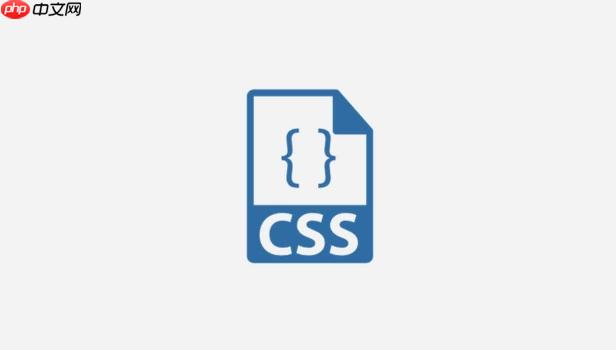答案:css通过伪元素、边框、阴影和变换等属性组合绘制图标,具有高性能、高可定制性和响应式优势,适用于简单单色ui元素,但复杂图标受限于代码复杂度与可维护性,建议结合SVG或字体图标使用。

CSS确实能画出各种符号和图标,它主要通过巧妙运用伪元素、边框、阴影以及变换等css属性的组合来实现。这种方式不仅能有效减少页面对外部图片资源的请求,提升加载速度,还能让图标拥有极高的可定制性,比如随意改变颜色、大小,甚至添加复杂的动画效果,这对于构建现代、响应式的用户界面来说,简直是太方便了。
解决方案
要用CSS绘制符号和图标,我们手头有几张王牌:
1. 伪元素 (
::before
,
::after
) 的魔法 这是我个人最常用,也觉得最灵活的手段。你可以把它们想象成是html元素内部的两个“隐形”小盒子,通过
content
属性来填充内容,或者直接把它们当作独立的形状来操作。
- 基本形状构建: 比如画一个简单的圆点,用
::before
或
::after
设置
display: block
,
width
和
height
相等,再加个
border-radius: 50%
就行。
- 复杂路径组合: 汉堡菜单图标就是个经典案例。一个
div
作为中间的横线,
::before
和
::after
分别作为上下两条线,通过
position: absolute
定位,
box-shadow
甚至可以用来模拟多层效果。
/* 示例:一个简单的汉堡菜单图标 */ .hamburger-icon { width: 30px; height: 3px; background-color: #333; position: relative; margin: 10px 0; } .hamburger-icon::before, .hamburger-icon::after { content: ''; position: absolute; width: 100%; height: 3px; background-color: #333; left: 0; } .hamburger-icon::before { top: -10px; } .hamburger-icon::after { bottom: -10px; }
2. 边框 (
border
) 的几何学 边框不仅能勾勒轮廓,它的某些特性还能创造出意想不到的形状。最典型的就是画三角形。当一个元素的宽度和高度都为0,但它的四条边框都有颜色和宽度时,你会发现它们交汇处形成了四个三角形。通过控制哪条边框有颜色,就能得到不同方向的三角形。
/* 示例:一个向上指的箭头 */ .arrow-up { width: 0; height: 0; border-left: 5px solid transparent; border-right: 5px solid transparent; border-bottom: 10px solid #333; /* 只有底部边框有颜色 */ }
3. 阴影 (
box-shadow
,
text-shadow
) 的层次感 阴影通常用来增加立体感,但它也可以被“滥用”来绘制形状。通过设置多个
box-shadow
,并且偏移量为0,模糊半径也为0,你可以堆叠出多个同尺寸的矩形,这在画一些点状或线条组合的图标时很有用。
4. 变换 (
) 的动态感
transform
属性简直是神来之笔,它可以让你的形状旋转 (
rotate
)、缩放 (
scale
)、倾斜 (
skew
) 甚至平移 (
translate
)。配合伪元素和边框,你可以用它来微调角度,或者直接把一个矩形变成菱形。
5. 字体图标 (Icon Fonts) 和 SVG 的辅助 虽然标题是CSS绘制,但实际项目中,我们往往会结合字体图标(如 Font Awesome)或内联SVG。字体图标本质上是把图标作为字符来使用,CSS可以像控制文本一样控制它们。SVG则提供了无与伦比的图形表达能力,复杂、多色的图标通常会选择SVG。CSS在这些场景下,更多是作为样式控制层,而不是直接绘制层。不过,CSS绘制的优势在于,对于那些简单、几何感强的UI元素,它能以最轻量的方式实现。
CSS绘制符号相比图片或SVG有何优势?
在我看来,CSS绘制符号的优势是显而易见的,尤其是在面对那些相对简单、单色的UI元素时。
立即学习“前端免费学习笔记(深入)”;
首先,性能方面,它简直是优等生。没有额外的http请求,浏览器不需要下载图片文件,直接解析CSS就能渲染,这对于页面加载速度的提升是实打实的。想想看,如果你的页面有几十个小图标,用图片就意味着几十次请求,而CSS绘制则能省下这笔开销。
其次,可伸缩性和分辨率无关性是它与生俱来的天赋。无论用户屏幕是多大的Retina显示屏,还是普通的低分屏,CSS绘制的图标都能保持像素级的完美呈现,不会出现模糊或锯齿。这跟矢量图(如SVG)有异曲同工之妙,但CSS绘制的门槛有时更低。
再者,极高的可定制性让我爱不释手。想要改变图标的颜色?改个
color
或
background-color
属性就行。想调整大小?改
width
和
height
。甚至想让它动起来?
和
@keyframes
动画信手拈来。这种灵活性是位图图片望尘莫及的,即使是SVG,有时候调整起来也不如CSS直接。维护起来也更方便,所有样式都在一个CSS文件里,集中管理。
当然,我不是说它完美无缺。面对复杂、多色的图标,CSS绘制会变得异常痛苦甚至不可能。但对于导航箭头、加载指示器、复选框、关闭按钮这类基础UI元素,CSS绘制就是那个“刚刚好”的解决方案,它在轻量、灵活和性能之间找到了一个绝佳的平衡点。
如何用CSS绘制一个可交互的加载动画图标?
绘制一个可交互的加载动画图标,最经典的莫过于那个旋转的圆圈,也就是我们常说的“Spinner”。这个东西用CSS实现起来,既优雅又高效。
核心思路是:
- 创建一个基础的圆环:用一个
div
元素,设置
border-radius: 50%
,然后通过
border
属性来画出圆环。
- 制造“缺口”或“颜色渐变”:让圆环的一部分边框颜色不同,或者完全透明,这样在旋转时就能看到一个“运动”的效果。
- 添加旋转动画:使用
@keyframes
定义一个从0度到360度的旋转动画,并应用到圆环上。
/* 示例:一个旋转的加载指示器 */ .loader { width: 40px; height: 40px; border: 4px solid #f3f3f3; /* 浅灰色背景圆环 */ border-top: 4px solid #3498db; /* 蓝色旋转部分 */ border-radius: 50%; animation: spin 1s linear infinite; /* 1秒线性无限旋转 */ } @keyframes spin { 0% { transform: rotate(0deg); } 100% { transform: rotate(360deg); } } /* 交互性:比如鼠标悬停时加速 */ .loader:hover { animation-duration: 0.5s; /* 悬停时加速到0.5秒一圈 */ }
这个例子里,
border-top
的蓝色就形成了那个“运动”的头部。
animation: spin 1s linear infinite;
让它以每秒一圈的速度无限旋转。至于交互性,我这里简单加了一个
:hover
伪类,让它在鼠标悬停时加速旋转。你甚至可以结合JavaScript,根据加载状态动态添加或移除这个动画,或者改变颜色来表示不同的状态(比如加载失败变红)。
我觉得这种纯CSS的加载动画特别有意思,因为它完全依赖于浏览器的渲染能力,省去了图片解码的开销,动画流畅度通常也很好。而且,它非常容易定制,想换个颜色、换个速度,或者把圆环变成方环(虽然那样就不叫spinner了),都只是改几个CSS属性的事。
CSS绘制复杂图标时可能遇到哪些局限和挑战?
尽管CSS绘制符号有很多优点,但它并非万能药,尤其是在面对复杂图标时,局限性和挑战就凸显出来了。
一个最直接的限制是复杂度的天花板。CSS擅长绘制几何图形、单色图标或者简单的线条组合。一旦图标需要多层渐变、复杂的曲线、精细的细节或者多种颜色组合,用纯CSS来绘制就会变得极其困难,甚至是不可能完成的任务。你可能会发现自己需要堆叠大量的伪元素、多重阴影,或者用
transform
进行各种微调,最终得到的CSS代码会变得非常冗长和难以维护。这时候,代码量可能比直接使用一张SVG图片还要大,而且可读性极差。
另一个挑战在于可维护性。当一个CSS图标的代码量达到一定程度,它就变成了一个“黑盒子”。别人,甚至是你自己,过一段时间再来看这段代码,可能会很难理解每个
div
、
::before
、
::after
以及各种
border
和
box-shadow
组合起来到底是为了画什么。调试起来也会很头疼,因为任何一个细微的属性调整都可能导致整个图标变形。这与SVG的路径定义清晰、语义化强的特点形成了鲜明对比。
语义化缺失也是一个问题。纯CSS绘制的图标本质上只是视觉元素,它们没有内在的语义信息。而SVG文件可以包含
title
和
desc
标签,方便屏幕阅读器理解图标的含义,这对无障碍性(accessibility)来说非常重要。当然,你可以通过给父元素添加
aria-label
来弥补,但这毕竟是额外的处理。
此外,浏览器兼容性有时也会成为绊脚石。虽然现代浏览器对css3的支持普遍很好,但如果你需要兼容一些老旧的浏览器,某些高级的CSS属性(比如
clip-path
或者复杂的
transform-origin
)可能会出现兼容问题,导致图标显示异常。
最后,开发效率也是一个考量点。对于那些需要高保真、像素完美的复杂图标,用CSS从零开始手绘,其投入的时间成本往往远高于设计师直接提供SVG或图片。在团队协作中,让前端工程师去“画”图标,而不是直接使用设计稿,也可能会拖慢开发进度。
所以,我常常觉得,CSS绘制图标是一个“术”的范畴,它有其适用的场景。当图标简单、颜色单一、需要高度定制和性能优先时,它是利器。但一旦超出这个范畴,毫不犹豫地转向SVG或者字体图标,才是更明智、更高效的选择。选择正确的工具,永远是项目成功的关键。


评论(已关闭)
评论已关闭